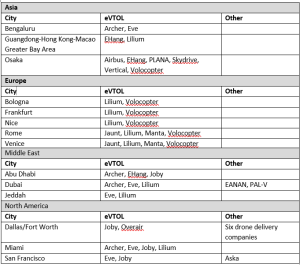
By Philip Butterworth-Hayes
Over the last few weeks, United Arab Emirates (UAE) States have announced major advanced air mobility (AAM) eco-system development plans[1], with eVTOLs starting widespread commercial services there as early as 2025.
As well as, almost overnight, altering the market dynamics of the global AAM market, these programmes present some of the toughest challenges facing airspace planners in the world today.
In Dubai, passenger carrying eVTOLs, large cargo freight drones and personal flying vehicles will soon be sharing the same airspace. In Abu Dhabi, autonomous EHang eVTOLs – with built-in UTM systems – will also be sharing airspace with piloted Archer and Joby eVTOLs using independent UTM systems. At least three vertiport companies are also developing infrastructure in the emirate, some with approach/departure UTM services integrated into their design and others without. Earlier this month Ras Al Khaimah announced it was developing an AAM eco-system based on a network of Skyports vertiports.
The UAE is not alone. The airspace above Dallas Fort Worth will soon be buzzing with six drone delivery companies and two eVTOL commercial operators sharing the same, or broadly the same, airspace.
The rapid advance of AAM is overtaking many of the “crawl, walk, run” UTM development schedules which States had been planning. Early trials of multiple operators flying beyond visual line of sight (BVLOS) drone missions in the same airspace are due to begin this year in many parts of the world, to test automated detect-and-avoid, communications and flight plan deconfliction tools. But before the results of these trials can be fully taken on board, airspace planners in Gulf States are now having to design operational UTM systems to manage a range of passenger-carrying operational vehicles flying in close proximity, with varying performance characteristics including piloted, remotely piloted and autonomous flight control systems.
Most early eVTOL-based AAM services will be based at current airports and fly VFR routes without the need for a UTM system. But in several cities of the world (see “The cities with complex airspace design challenges”) multiple eVTOL companies are planning to develop competing operations, which will require the establishment of complex UTM eco-systems if these operations are to scale as planned.
The cities with complex airspace design challenges

Source: Global AAM/UAM market map
While there are plenty of high-level concepts-of-operation for urban UTM now available, there are wide differences around the world in how drone-based UTM architectures can be evolved to manage eVTOLs and personal air vehicles, equipped with different sensors and communications systems. In Europe, the European Union Aviation Safety Agency (EASA) sees AAM UTM operations as, broadly, an extension of U-space, developed to manage complex drone operations. In the USA, the Federal Aviation Administration is encouraging UTM service providers and other data providers to develop their own standards and procedures to share safety critical data in urban areas, as part of its UTM Key Site initiative.
Airspace managers in Saudi Arabia and the United Arab Emirates now face a series of daunting tasks – institutional and technical – in developing a single UTM system which can accommodate drones, eVTOLs, personal flying vehicles, general and commercial aviation, vertiports and airports into a cohesive network. Because of the short timescale involved, the work will have to be centralised, with air navigation service providers (ANSPs) providing the leading role in developing, operating and evolving the systems, backed by central government funding. This is a long way away from decentralised, industry-funded UTM architecture business model favoured by many.
The task for Saudi Arabia will be slightly easier than in the UAE, where there are multiple government agencies in involved in promoting the AAM industry. Earlier this year, Saudi Arabia’s General Authority of Civil Aviation (GACA) launched its Advanced Air Mobility (AAM) in Saudi Arabia initiative and has already developed a more detailed urban UTM concept of operation to manage eVTOL flights at NEOM, with Saudi Air Navigation Services (SANS) playing the leading role.
With every challenge, there is an opportunity.
Because of the complexities and timescales involved, ANSPs will be encouraging their regulators to devolve responsibilities for all low-level airspace management to ANSPs. For example, UK ANSP NATS is seeking feedback from stakeholders for its Open Air airspace management concept where it has partnered with Altitude Angel for drone traffic management and Eve Air Mobility for eVTOL operations to provide a long list of UTM-services from a single platform. Industry is starting to move in this direction, too. The recent announcement that Unifly, Terra Drone and Aloft Technologies were together developing “a global UTM infrastructure that kickstarts AAM industry worldwide,” is another example of the way UTM system developers are now pivoting towards AAM. Although, in fairness, many other UTM companies have occupied this space for years.
It is difficult not to compare the continued crawl rate with which many regulators are advancing automated flight approvals for BVLOS drone operations to the sprint speed with which these same regulators plan to advance AAM operations – and, as a result, the contrasting business opportunities which UTM service providers can expect from both sectors. This is, perhaps, an oversimplification. But how Gulf states, technically and institutionally, manage the development of UTM systems to support their hugely ambitious AAM programmes will provide many transport departments worldwide with an early example of what will work, and will not, in complex low-level airspace management.
[1] https://www.urbanairmobilitynews.com/vertiports/23834/ https://www.urbanairmobilitynews.com/air-taxis/joby-partners-with-abu-dhabi-to-establish-electric-air-taxi-ecosystem/

